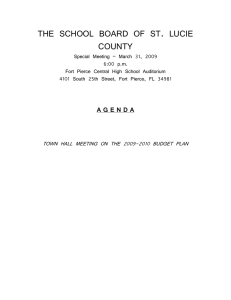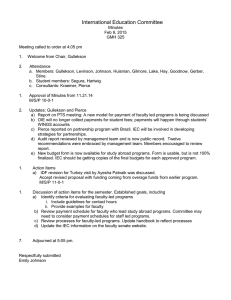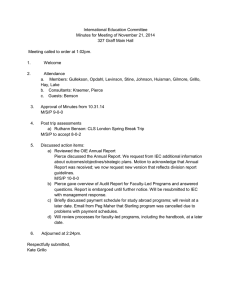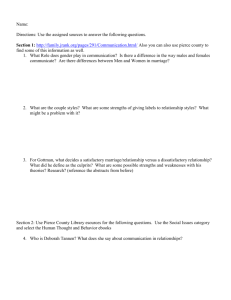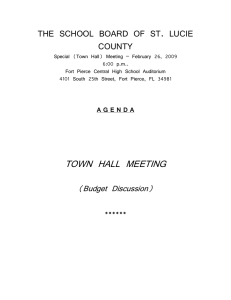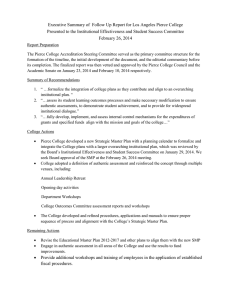Pierce County Sustainable Economy Study Briefing Report
advertisement
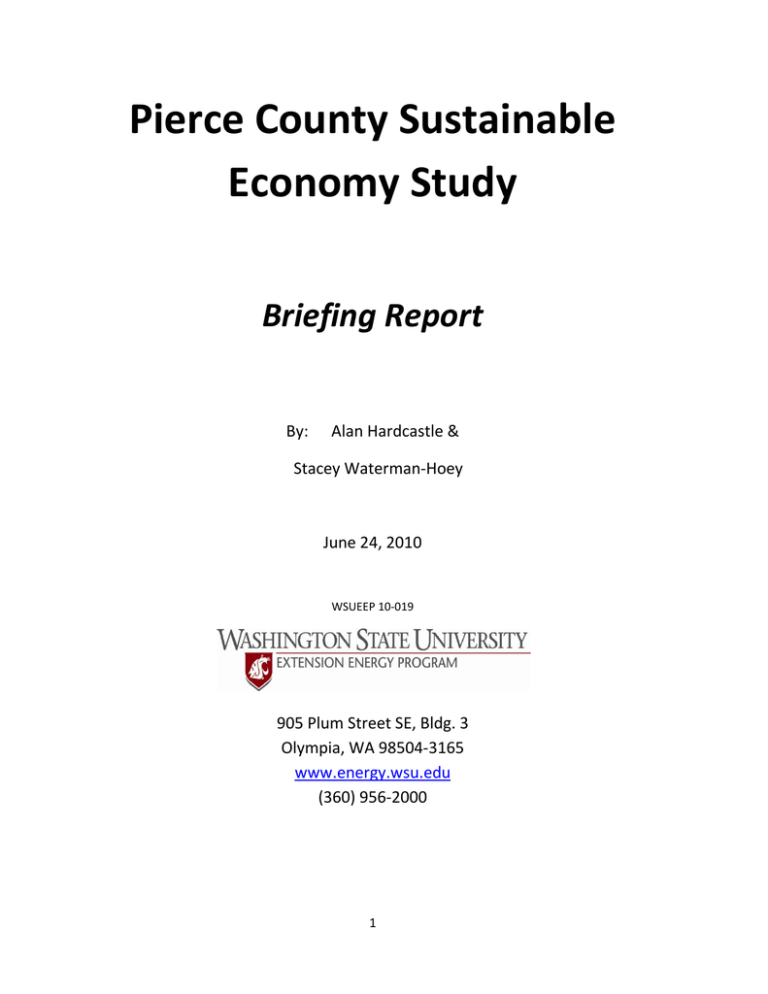
Pierce County Sustainable Economy Study Briefing Report By: Alan Hardcastle & Stacey Waterman-Hoey June 24, 2010 WSUEEP 10-019 905 Plum Street SE, Bldg. 3 Olympia, WA 98504-3165 www.energy.wsu.edu (360) 956-2000 1 2 Pierce County Sustainable Economy Study Briefing Report Abstract A number of public and private-sector organizations in Pierce County and the City of Tacoma are pursuing goals and initiatives that relate directly or indirectly to the development of a sustainable economy for the region. This report outlines a conceptual model for how regional sustainability research, relationships and resources can be identified, analyzed and applied to assist stakeholders as they work to achieve sustainability goals. The report also provides context for sustainability initiatives, presents county population and economic data, and introduces data specific to Pierce County from the 2009 Washington State Green Economy Jobs Report. Background and Purpose Public and private-sector organizations in Pierce County and the City of Tacoma are actively engaged in a number of initiatives and activities that relate to the development of a sustainable economy for the region. The focus on sustainability comes from many different sources and organizations, with financial support from federal, state and local grant funds and in-kind resources provided by a number of organizations. The objectives of many of these regional sustainability goals and activities are multi-faceted. Indeed, the rationale for developing a sustainable economy in Pierce County varies by organization, ranging from enhancing environmental protection and public health, to jump-starting the regional economy, boosting innovation and creating new employment opportunities for citizens. The purpose of this briefing report is to provide a common background and context for a broader project aimed at supporting the efforts of regional partners who are establishing and pursuing elements of a sustainable economy in Pierce County. The project provides a discussion forum and a data-driven research base that can be used by the partners to leverage relationships, resources and research data to implement effective sustainability strategies and achieve targeted outcomes. The focus on sustainability has been accelerating in the county and along with it, interest in a cohesive and strategic path forward that can help to maximize the individual efforts of various organizations while avoiding duplication of effort. The overall intent is to bring together the partners, identify available resources and common goals, and provide a research foundation for sustainability strategies and actions that will enable coordinated action and the achievement of sustainability goals. As part of the project, a conceptual model was developed to describe a general process for how regional sustainability-related research, relationships and resources can be identified, analyzed and applied to assist stakeholders (individually and collectively) as they work to achieve sustainability goals. This “ResearchRelationships-Resources” (RRR) model provides an organizing strategy for how sustainability partners compile and share information on various activities, research and data which could be useful in advancing sustainability. The information could include data, reports or studies, ongoing activities, specific knowledge 3 or skills, available sources of funding, the expertise of certain partners, stakeholders or projects, etc. These resources will become the foundation for helping stakeholders to identify new or existing opportunities, as well as to identify the potential needs for additional information to advance sustainable economy goals in Pierce County. Figure 1 depicts the RRR model. The model includes several main content and process elements, and depicts a general flow of knowledge and information that is intended to culminate in specific actions and outcomes. At the top, which represents the beginning of the process, are the various resources available to the partners. These could include, for instance, existing research or new data collected by the partners, information about infrastructure, new funding or existing resources, or knowledge about specific partnerships that could be useful to advance regional sustainability goals. As these resources are identified, they can be organized, presented and discussed by stakeholders during regional forum events, shared electronically or in other forms that are accessible and useful to regional stakeholders and partners. If information gaps are identified that are limiting the ability of stakeholders to pursue common sustainability goals, targeted research might be directed to help answer specific questions or address topics of common interest to the stakeholders. If at some point during the analysis new information is discovered or generated, this new information could be integrated into the model and used to refine and improve the decision-making processes and actions of stakeholders. In short, the RRR model and process is designed to identify opportunities for stakeholders to maximize the use of existing resources, leverage the relationships and capacities of sustainability partners, and target specific data and information needs to advance development of a sustainable economy in Pierce County. This coordinated approach is intended to enhance decision-making and guide collective action in support of regional sustainability goals. The model operates as an open system that encourages the incorporation of new data, resources and partners, and can be refined by the partners to adapt to changing conditions, opportunities and the needs of stakeholders. 4 Figure 1 - The Research, Relationships, Resources Model (RRR) 5 The Context for Sustainability Conceptually, the term “sustainable” seems straightforward. The Merriam-Webster definition, for example, alludes to the use of a specific resource (i.e. a crop) such that the resource is not permanently depleted or damaged. Using sustainable harvesting practices is one method of helping to ensure that a crop resource is not depleted. Looking more broadly, sustainability also refers to a lifestyle in which the prudent use of resources and sustainable methods benefits society and future generations. In practice, however, the term is enormously complex, and there are many different definitions in use today. Washington State Governor Christine Gregiore has described the shift towards sustainability as follows: "I think we all must engage in a strategy of sustainability. This means our society has to integrate our economic vitality and our environmental integrity into a new kind of prosperity for our state - one that enriches today without impoverishing tomorrow.” The United Nations published Our Common Future (aka The Brundtland Report) in 1987 which became the cornerstone document of the sustainability movement. The following definition regarding sustainable development remains the most oft-cited definition of sustainability: Sustainable development is: “development that meets the needs of the present without compromising the ability of future generations to meet their own needs.” Subsequent definitions of sustainability began to incorporate specific dimensions around which sustainable goals and activities could be pursued. For instance, in addition to environmental protection, some definitions emphasized and incorporated economic and societal dimensions to sustainability as well. The following definition, which first appeared in the 2000 Earth Charter report, describes three pillars of sustainability. Collectively, the pillars are often described as the core targets of sustainability needed to achieve a “Triple Bottom Line.” (Figure 2): The three pillars of sustainability include the environment, social equity, and the economy. A strong resilient economy depends upon a vibrant and equitable society which in turn relies on a vigorous flourishing environment. The balance of the three pillars leads to prosperity and peace for future generations. 1 1 For more information about the Earth Charter, see: http://www.earthcharterinaction.org/content/ 6 Figure 2 - The Three Pillars of Sustainability While there are overt and sometimes subtle differences among these definitions, there is a common theme: the shift toward more efficient, fair and conscientious use of resources. Support for sustainability has gained momentum over the last several decades, but growing social inequities, concerns about energy security and rising energy prices, and the effects of the Great Recession have combined to accelerate social and political support for policies and practices that promote sustainability. The concept of sustainability has been adapted in a myriad of ways. Some of the more common adaptations include using core sustainability principles in specific topic areas: Sustainable Management: Managing environmental and resource systems so that their ability to support future generations is not diminished. Sustainable Business: Ensures all processes, products and manufacturing activities adequately address environmental concerns while maintaining a profit. Sustainable Economy: The number of people and quantity of goods are in equilibrium; The level of equilibrium is ecologically sustainable over time while meeting the basic needs of all members. Green Economic Development: Integrates economic development—tax base expansion, wealth creation, and job creation—with the values of sustainability. There are a number of reasons commonly cited by proponents for why public and private-sector organizations should learn and adopt sustainable principles and practices. Often these reasons target the tangible benefits to businesses, including: Appeals to a growing customer base. Attracts and retain employees who share the organization’s commitment to sustainability. 7 Reduces risk, lowers operating costs, and helps to ensure that essential raw materials are available in the future. Supports the local economy, which in turn can better support the organization. Demonstrates accountability to the public and to the welfare of the surrounding community, employees and customers. There is a compelling business case for sustainability: Recent research is finding a strong correlation between businesses with strong sustainability leadership and positive financial indicators such as return-oninvestments and earnings per share. Corporate commitment to sustainability is having a positive impact on business successes.2 According to one source, between 50 and 90 percent of a company’s market value can be attributed to ‘intangibles’, such as policies and practices that promote the triple bottom line.3 Properly measuring and communicating these ‘intangibles’ can help turn them into real and strategic resources, as companies gain a reputation for proactively managing risk and providing responsible and innovative leadership. Most businesses have taken at least some action to improve sustainability. It could be as simple as implementing a recycling program, or promoting employee ride-sharing programs to conserve energy and reduce environmental impacts. Many businesses are now going well beyond these initial steps by conducting internal sustainability reviews, adopting supportive policies and practices, and developing datadriven sustainability management plans. “Corporate Sustainability” (an evolution of the ethics-focused term Corporate Social Responsibility) is an increasingly-popular goal being pursued by businesses that creates long-term shareholder value as companies embrace new markets and product opportunities, implement organizational improvements, and manage the social, environmental and economic risks associated with pursuit of the triple bottom line. One common component of a Corporate Sustainability Plan is a ‘Life Cycle Assessment’ (LCA) of individual products used or produced by the business. An LCA is a cradle-to-grave environmental impact review of a product. It includes, for instance, an analysis of materials extracting and processing, manufacturing, transportation and distribution, use, re-use, maintenance, recycling, and final disposal. Another component of a Corporate Sustainability Plan is a review of social implications of the business’s activities. This may include a review of wages, indigenous people’s rights, working conditions, educational opportunities and other factors. The Corporate Sustainability Plan (CSP) lays out this information and then describes specific actions the company will take to reduce identified negative impacts of targeted business activities. To the extent possible, actions are measured, goals set and indices of success are created. Actions taken as a result of such 2 See: Nidumolu, R., Prahalad, C, & Rangaswami, M. (2009). Why sustainability is now the key driver of innovation. Harvard Business Review (September). See also: Oekom Research, Sustainability and Business Success, 6/2005 http://www.oekom-research.com/index_en.php?content=studien. Also: Schaltegger and Wagner, Managing and Measuring the Business Case for Sustainability: Capturing the Relationship between Sustainability Performance, Business Competitiveness and Economic Performance, 2006. 3 Global Environmental Management Initiative, Clear Advantage: Building Shareholder Value http://www.gemi.org/resources/GEMI%20Clear%20Advantage.pdf 8 plans also serve to optimize the overall performance and well being of an entire company. CSPs frequently include and target suppliers.4 Many large corporations have developed CSPs to guide major sustainability initiatives. Starbucks Corporation’s 2009 Global Responsibility Report assesses the environmental impact of their activities, and the company is also working to improve fair trade and work conditions for coffee farmers. 5 An independent third-party assessment was conducted to verify the company’s activities. These plans are unusual because they reveal proprietary information, making it available for shareholders and the general public to scrutinize. But along with this disclosure is an opportunity for companies to discuss the actions they are taking—and the results they are achieving—with customers and shareholders alike. Greater transparency and information sharing signals to investors that these companies are open about their activities and describes how they are actively reducing their exposure to risks, maximizing operational efficiencies, and providing long-term value to customers and investors. Pierce County Population and Economic Data Developing a sustainable economy in Pierce County will be influenced by current and future population trends and other economic factors in the region. Indeed, Pierce County’s unique population and economic profile reveals benefits and challenges that may ultimately affect the content, focus and success of regional sustainability initiatives. A clear and accurate picture of the region’s distinguishing characteristics can help to inform and guide education and training program development efforts, for instance, to leverage strengths while also addressing current or future gaps. Population: Population trends nationally, in Washington State and in Pierce County show that large numbers of ‘baby boomers’ are approaching retirement age (Figure 3.) At the same time, the number of working-age individuals is forecast to decline through 2030, causing an overall reduction in labor supply. Figure 2 - Percent of Population by Age Group, 2006 9% U.S. State Pierce 8% 7% 6% 5% 4% 3% 2% 1% 85 + 80-84 75-79 70-74 65-69 60-64 55-59 50-54 45-49 40-44 35-39 30-34 25-29 20-24 15-19 10-14 5-9 0-4 0% Age Group 4 Source: Washington StateSustainability Employment Security Dept, Workforce Pierce County Profile 2008 See Walmart’s Supplier Assessment activities: Explorer, http://walmartstores.com/Sustainability/ and IBM’s Supply Chain Responsibility Initiatives: http://www.ibm.com/ibm/responsibility/supplychain.shtml 5 Starbucks Global Responsibility Report: http://www.starbucks.com/responsibility 9 In other words, there will be fewer young people (ages 5-24) in Pierce County moving into the workforce pipeline to replace the current and aging workers. The county has somewhat more young people than the state and national average, however with a retirement bubble coming, there are still fewer people overall to replace those exiting the workforce. Additionally, the new workers are going to be more ethnically diverse than the current workforce. These groups are currently under-represented in post-secondary education and require more remedial education and training. As the number of workers decrease in the future, reliance on female workers will increase. Occupations and industries which have not traditionally drawn significant numbers of women will find they need to do more to attract and prepare new workers. Figure 4 shows the current and projected age of the population in Pierce County. The good news revealed in this data is that the future population will be more evenly distributed across age groups and therefore more stable (Figure 4, dark bars). The bad news is that there will be fewer available workers overall in the future than there are today. Additionally, in the short term (lighter bars) many of the most experienced workers are nearing retirement. Figure 3 - Percent of Population by Age Group, Current and Projected, Pierce County 2006 9% 2025 8% 7% 6% 5% 4% 3% 2% 1% 85 + 80-84 75-79 70-74 65-69 60-64 55-59 50-54 45-49 40-44 35-39 30-34 25-29 20-24 15-19 10-14 5-9 0-4 0% Age Group Source: Washington State Employment Security Dept, Workforce Explorer, Pierce County Profile 2008 Pierce County is in a somewhat better position than the state or the U.S. because a comparatively larger proportion of young people of working age are forecast to be available over the next 15 years (as shown in Figures 3 and 4). Research shows that labor shortages due to retirements in industries such as energy and manufacturing are likely to be severe.6 Some of these industries have begun to initiate succession planning but a great deal more work will be needed to prepare the upcoming workers. Although the recent recession has slowed the loss of experienced workers to retirement, at some point the economy is expected to recover and with it, a resumed interest among workers of retirement age to leave the labor force. Indeed, the recession may even exacerbate the problem of how to replace retirees in many industry sectors, as the number of workers qualified to retire will continue to grow through the recovery. 6 Hardcastle, Alan. Workforce Challenges of Electric Sector Employers in Washington and Oregon, Jan. 2008. http://www.energy.wsu.edu/apps/Workforce.aspx 10 Ethnic Composition: Figure 5 reveals that ethnic and racial minorities constitute a higher percentage of the current population in Pierce County than the state as a whole and Thurston County, Pierce’s neighbor to the south. The rate of growth in minority populations is projected to increase at a faster rate than the population as a whole – each of the minority groups shown in Figure 5 is growing. Currently more than one in four Pierce County residents self-identify as a racial or ethnic minority. Figure 5 - Racial and Ethnic Minorities, Washington State and Selected Counties, 2000 and 2008 35% 10% 3% 3% WA State 2000 0% 9% WA State 2008 5% 7% 6% 7% 7% 7% 5% 7% 5% 6% 1% 1% 3% 3% 6% 5% Indian Two or More Races Asian Pacific Islander 5% 5% Hispanic 2% 3% Black Thurston 2008 6% 13% 11% King 2008 7% 1% 3% King 2000 15% 1% 3% 1% 1% 4% 4% 7% 6% Pierce 2008 20% 1% 3% Pierce 2000 25% 1% 3% Thurston 2000 30% Source: Washington State Office of Financial Management/Census Bureau Educational Attainment: It is widely known that minorities are currently underserved by the education system. For example, 53% of Washington’s Hispanic population 25 years or older has completed high school or equivalency, compared to 90% of whites in the same age group.7 College enrollment and degree completion rates in Washington are also lower for Hispanic, African American and American Indian students than for whites and Asians.8 If this trend continues—and unless greater outreach and resources are invested to improve student participation, retention and program completion—there is a real risk that, as the future workforce becomes more ethnically diverse, they may be less well-prepared than the current workforce they will be replacing. 7 Long-term Economic and Labor Force Forecast for the State of Washington, Washington State Office of Financial Management 8 Diversity in Washington: Higher Education, Higher Education Coordinating Board, Sept 2006. 11 Figure 6 shows the educational attainment levels of the adult population in Pierce Co relative to the state and the nation. Pierce County is fortunate to have a comparably high rate of high school graduates and adults with Associate’s degrees. Surprisingly however, fewer adults in Pierce Co are likely to achieve a Bachelor’s degree or higher compared to the national or state average. It is unclear why so many students are earning Associates degrees but not four-year degrees or higher. Figure 6 - 2006 Educational Attainment Level for U.S., Washington State and Pierce County 35% U.S. 30% State Pierce 25% 20% 15% 10% 5% 0% No High School Diploma High School Some College Associate's Diploma/GED Degree Bachelor's Degree Master's or Higher Source: Washington State Employment Security Dept, Workforce Explorer, Pierce County Profile 2008 Employment: Employment in Pierce County is down significantly in response to the global recession. However, monthly data released in March, 2010 reveals the first significant addition of new jobs (1,800) since 2007. Another 500 jobs were added in February, however some of those jobs are known to be temporary positions, such as census workers. State employment statistics for Pierce County suggests the recession has probably ended, though the recovery is expected to proceed slowly, with modest new job growth. Pierce County has faced greater challenges to employment than many of its neighbors. Figure 7 shows that Pierce County employment in April, 2010 is down about 6% compared to April, 2008.9 9 Washington State Dept of Employment Security, LMEA, Workforce Explorer: https://fortress.wa.gov/esd/lmea/countydashboard/NonfarmDetails.aspx?area=53_04_000053&qtype=1&comp=&ind 1=00000000&ind2=&ind3=&expand=true 12 Figure 7 - Pierce County Employment, 1990-2010 Source: Washington State Employment Security Dept, LMEA, Workforce Explorer The corresponding unemployment rate is up significantly as shown in Figure 8. The unemployment rate in Pierce County is equal to the national average (9.3%), which is higher than the state average (8.7%). Pierce County’s unemployment rate is also much higher than for neighboring counties (also shown in Figure 8). Thurston and King County unemployment rates were tied at 7.5% as of April, 2010. Figure 8 - Pierce, Thurston and King County Unemployment Rates, 2000-2010 Source: Washington State Employment Security Dept, LMEA, Workforce Explorer 13 Employment by Industry: The jobs that were added in Pierce County in March were all private industry jobs across a broad range of industries. The goods-producing sector accounted for 400 new jobs while the remaining 1,400 were in service-providing industries. Manufacturers cut 200 jobs. Seasonal construction added about 600 workers this month. The trade/transportation/utilities sector, hospitality and information services each added about 400 jobs. Retail trade and restaurants added about 200 new jobs.10 Figure 10 shows employment within the major industries of Pierce County. The Government sector, with 28% of employees in the county, includes schools, local and county government and public utilities as well as civilian employment by the military. The next largest segment is the Trade, Transportation and Utilities sector at 25%. At just eight percent, the manufacturing sector contributes a fairly small percentage of total employment in the County. Figure 10 - Pierce County Employment by Industry, March, 2010 Leisure and Hospitality 23,800 (12%) ProfessionalBusiness Services 23,000 (11%) Construction 17,700 (9%) Total Non-farm Employment, 3/2010: 263,100 Manufacturing 15,800 (8%) Trade, Transp and Util 51,200 (25%) Other Services 12,200 (6%) Information 3,600 (2%) Government 58,700 (28%) Natural Resources-Mining 300 (0.1%) Source: Washington State Employment Security Dept, LMEA, Tacoma Metropolitan District Labor Area Summary, March, 2010 These industries are not static; each is at a different stage of growth or decline, however there are a few pervasive trends. Table 1 lists the number of employees by industry type and the change in employment levels between 2008 and 2009. Within the goods -producing sector, many jobs were lost during the recession. By the end of 2009, this sector employed 34,900 workers, down 13.8% compared to December of 10 Washington State Employment Security Dept, LMEA, Tacoma Metropolitan District Labor Area Summary, March 2010 14 2008. Included in this category is Mining and Logging, a very small employment category which experienced a 25% drop in employment. The largest total employment declines were in Construction, which dropped 15.6%, followed by Manufacturing which dropped 11.6% by December of 2009. Short-term employment projections suggest that employment in goods-producing sectors will continue to decline, however those declines will be more moderate than in the recent past. The service-providing sector fared much better over the same period. The service-providing sector is also substantially larger than the goods-producing sector, with 232,400 employees. Compared to goodsproducing employment, the services sector saw employment decline by just two percent during the same period. Within this sector, information-related jobs experienced the greatest losses as 11.1% of its workforce was eliminated. However, with a base of just 3,200 employees, the total employment decline in this sector was small compared to other service sub-sectors. Table 1 - Pierce County Employment by Industry Dec 2009 Employees (prelim) Goods Producing (Total) 34,900 Mining and Logging 300 Construction 17,900 Manufacturing 16,700 Service Providing (Total) 232,400 Trade, Transportation and Utilities 53,700 Information 3,200 Financial Activities 12,100 Professional and Business Services 23,600 Educational and Health Services 43,900 Leisure and Hospitality 25,100 Other Services 12,200 Government 58,600 Dec 2008 (% change) -13.8% -25.0% -15.6% -11.6% -2.0% -3.9% -11.1% -7.6% -0.8% 2.3% 6.7% -2.4% 0.2% Avg Annual Growth Rate 20082013 -2.4% -5.6% -2.8% -2.2% .8% .1% 3.5% .3% 2.1% 2.9% -.1% .5% .2% Source: Pierce County Long-term Occupation Employment Projections, Washington Employment Security Dept Labor Market and Economic Analysis The largest categories within the services sector are government with 58,600 employees, which increased .2%; trade, transportation and utilities with 53,700 employees, which decreased 3.9%; and educational and health services with 43,900 employees which increased 2.3%. Leisure and hospitality experienced the largest increase in employment (6.7%) and has more employees (25,100) than any category under the goods-producing sector. In contrast to employment in goods-producing industries, employment in the service sector is projected to grow modestly in the mid-term, with growth in some sub-sectors exceeding the average for all service providers of less than one percent (0.8). Table 3 shows the growth rate for the fastest and slowest growing occupations. The fastest-growing occupation in Pierce County is expected to be Manicurists and Pedicurists. The occupation seeing the most rapid decline is Forest, Conservation and Logging Workers. 15 This table only shows the top and bottom 15 occupations but the trend continues throughout the list of hundreds of occupations. Generally speaking, the data suggest that employment in jobs related to manufacturing and other goods-producing sectors are expected to continue to decline, while those in the services category are expected to grow most rapidly; high-skill, high-wage occupations will continue to be replaced by employment in lower-skill and lower-wage occupations. Table 2 - Pierce County 10 year Occupation Growth Rate Projection (2007-2017) 15 Occupations with Highest Growth Rate Manicurists and Pedicurists Network Systems and Data Communications Analysts Desktop Publishers Personal Financial Advisors Hazardous Materials Removal Workers Hairdressers, Hairstylists, and Cosmetologists Medical Assistants Private Detectives and Investigators Veterinary Technologists and Technicians Personal Appearance Workers Ambulance Drivers and Attendants, Except Emergency Curators Anesthesiologists Employment, Recruitment, and Placement Specialists Interior Designers 15 Occupations with Lowest Growth Rate Forest, Conservation, and Logging Workers Logging Equipment Operators Grinding, Lapping, Polishing, and Buffing Machine Reporters and Correspondents Molding, Coremaking, and Casting Machine Setters, Furniture Finishers Electrical and Electronic Equipment Assemblers Grinding and Polishing Workers, Hand Aircraft Structure, Surfaces, Rigging, and Systems Computer-Controlled Machine Tool Operators, Metal Numerical Tool and Process Control Programmers Machine Feeders and Offbearers Extruding and Drawing Machine Setters, Operators Prepress Technicians and Workers Tool and Die Makers 4.0 3.7 3.3 3.1 3.0 2.9 2.7 2.7 2.6 2.6 2.6 2.4 2.4 2.3 2.3 -3.2 -3.2 -3.0 -2.8 -2.7 -2.6 -2.5 -2.5 -2.4 -2.4 -2.3 -2.2 -2.1 -2.0 -1.9 Source: Pierce County Long-term Occupation Employment Projections, Washington Employment Security Dept Labor Market and Economic Analysis 16 Green Economy Jobs In 2009, the Washington State Legislature conducted a survey of public and private employers to track industry and job growth in the state’s emerging green economy.11 The survey determined the number and type of green jobs in the state, and compared the results from 2009 to a baseline established in 2008. The survey was part of the Evergreen Jobs Act (E2SHB 2227) which intends to identify strategic green industries in the state and to support programs to train workers in green-economy industries and jobs. ‘Green jobs’ are defined in the survey as those where employees are directly and predominately engaged in at least one of the four green-economy core areas: Increasing energy efficiency Producing renewable energy Preventing and reducing environmental pollution Providing mitigation or cleanup of environmental pollution The 2008 study surveyed only private-sector employers. The 2009 survey included both private and public sector employers. The surveys resulted in two studies, the 2008 and 2009 Washington State Green Economy Jobs. These studies concluded that rather than a separate economy, Washington’s economy is already green and getting greener. They have also shown a large increase in the overall number of green jobs identified by employers, and that green jobs exist in nearly all industries across the state, although concentrations vary. Most of the growth appears to be in existing occupations with traditional job titles. These increases are probably due to a combination of factors: a larger survey sample of employers and industries was drawn in the second survey, and employers are becoming more aware of the qualities of a green job. While some new hiring may have occurred, in the current economic climate it is probably more likely that employers have restructured existing jobs to reflect the types of ‘green’ products and services they offer, as well as increased use of sustainable business practices. Washington State Green Economy Jobs: The 2009 Green Economy Jobs Report reported an estimated 76,137 private-sector green jobs and an additional 23,182 public-sector green jobs for a state-wide total of 99,319. This is about 3.3 percent of the total covered employment in the state, up from 1.6 percent in 2008. Among the private-sector industries which were surveyed both in 2008 and 2009, the number of jobs identified by employers as ‘green’ grew by 32.4 percent (15,100 jobs.) In 2009, the construction industry had the most green jobs with 29, 410 (38.6 percent) followed by agriculture with 12,027 green jobs. Based on secondary data sources, the 2009 report found that total annual average earnings for all green jobs in the state amounted to more than $5.1 billion. The median annual earnings are generally highest for professional or technical occupations that require long-term, post-secondary education or degrees, such as managers and engineers. The twenty-five occupations with the largest number of green jobs required mid- 11 For the full report, see: http://www.workforceexplorer.com/admin/uploadedPublications/10258_Green_Jobs_Report_for_Web_2009.pdf 17 level training or education, or the equivalent of one to four years of post-secondary coursework or on-thejob training. Such occupations include electricians, carpenters and managers. Pierce County Green Economy Jobs: Since the employer and jobs data was collected and coded for each of the state’s Workforce Development Areas, it was possible to analyze jobs data specifically for Pierce County. This data is highlighted in the following section. All tables are based on primary and secondary data collected by the Washington State Employment Security Department.12 Table 3 shows the share of green jobs in the public and private sectors and the total number of green jobs for Pierce County and Washington State. Pierce County has 11.8 percent of the state’s population but only 7.4 percent of the state’s green jobs. Total green jobs in Pierce County represent 2.7 percent of all covered employment in the county. Table 3 - Public and Private Green Jobs in Pierce County and Washington State Pierce County Washington Public 1,630 23,182 % 22.2% 23.3% Private 5,719 76,137 % 77.8% 76.7% Total 7,349 99,319 Table 4 shows the number of positions distributed across the four green core areas. The largest number of positions (3,671) relate to reducing pollution. This category represents 50 percent of the green employment in Pierce County. The energy efficiency category is responsible for the next largest number of positions with employment of 2,707. This represents 37 percent of the green jobs in Pierce County and 7 percent of all energy efficiency jobs in the state. Renewable energy jobs are not very common with only 105 positions representing only 1 percent of the green jobs in the county and 3 percent of renewable energy jobs in the state. Cleaning-up pollution accounts for 13 percent of the green jobs in the county and 8.1 percent of state-wide jobs in this category. Table 4 - Green Jobs by Core Area Pierce County Energy Efficiency Renewable Energy Reducing Pollution Pollution Clean-Up TOTAL GREEN JOBS Total Covered Employment 2008 3Q 12 Total Green Positions 2,707 105 3,671 939 7,349 275,499 % of State jobs in each category 7.0% 3.0% 8.0% 8.1% For more information on ESD data and reports, see: http://www.workforceexplorer.com/ 18 Table 5 shows the number of green jobs by industry categories. The construction industry contains the largest number of green jobs of any industry in Pierce County with 2,430 positions. This represents 8.3 percent of all green construction industry jobs in the state. Statewide, the construction industry represents 29.6 percent of all green jobs. Pierce County has high numbers of green jobs relative to the state in “Other Services,” however this is a catch-all category comprising employment in service jobs that do not easily fit within existing categories.13 Other industries show a high proportion of green jobs in Pierce County compared to the state, but these data are not included below as they are based on a small number of cases and are not deemed to be reliable estimates of employment. Table 5 Pierce County and Washington State Green Jobs by Industry Categories Industry Construction Public Administration Admin and Waste Mgmt. Professional Services Wholesale Trade Manufacturing Other Services Transport. and Warehousing Agriculture Utilities Grand Total Pierce Co. Green Jobs 2,430 1,630 1,128 596 516 426 353 96 84 42 7,349 WA Total Green Jobs 29,410 23,182 9,414 10,914 4,494 5,739 1,419 1,708 12,027 461 99,319 Pierce as % of All WA Green Jobs 8.3% 7.0% 12.0% 5.5% 11.5% 7.4% 24.9% 5.6% 0.7% 9.1% 7.4% Table 6 lists the top eight green occupational categories. These eight categories make up 97 percent of all green jobs in Pierce County. Construction and extraction-related occupations represent 34 percent of all green jobs in the county and 9.9 percent of the jobs within this category state-wide. Building and Grounds Cleaning and Maintenance occupations are responsible for 22.1 percent of all state-wide jobs within this category. Transportation and Materials Moving also holds a large state-wide share of green jobs in this category at 11.5 percent. 13 This category includes employment in autobody repair shops, beauty salons, and dry cleaners, for instance. 19 Table 6 - Top Eight Green Occupational Categories Top 8 Green Occupations Construction and Extraction Transportation and Material Moving Installation, Maintenance, and Repair Architecture and Engineering Production Building and Grounds Cleaning and Maintenance Management Life, Physical, and Social Science Grand Total (Includes All Occupations) Pierce Co. Green Employment % of Pierce Co. Green Employment 34% 21% 14% 10% 8% 2,519 1,509 999 710 563 430 229 154 7,349 % of Statewide Jobs 6% 9.9% 11.5% 10.9% 4.1% 10.1% 22.1% 3% 2% 4.3% 2.1% Table 7 correlates green occupations with the median annual earnings for those occupations. Pierce County’s median annual earnings for all occupations (including non-green) is approximately $36k per year. The median earnings for most of these green occupations are above the median for all occupations. The highest paying jobs also require highly skilled workers such as engineers and heating/ventilation/air conditioning specialists. The most numerous green occupations in the county are in transit-related jobs and construction. The estimated combined average annual earnings for all green jobs in Pierce County is $338 million. The estimated earnings statewide is $5.1 billion. Earnings from green jobs in Pierce County are estimated to count for 6.6 percent of the statewide earnings from these jobs. Table 7 - Median Annual Earnings for Top Green Occupations Bus Drivers, Transit and Intercity Construction Laborers Bus Drivers, School Carpenters Production Workers Truck Drivers, Heavy and Tractor-Trailer Roofers Civil Engineers Operating Engineers / Const Equip Operators Heating, Air Conditioning, and Refrigeration Mechanics and Installers 20 # of Green Jobs in Pierce Co 582 508 454 435 328 309 290 260 238 Median Annual Earnings $46,008 $38,674 $35,732 $44,619 $22,241 $42,932 $39,902 $75,814 $62,131 235 $55,096 Table 8 shows the response from Pierce County and Washington State employers when asked whether skills differ between green and non-green jobs. The vast majority (97.2 percent for Pierce County, 95.5% for Washington) of skills in green occupations were identified as being identical or mostly the same as nongreen occupations. Only a small number of employers indicated that the skills of workers in green jobs were either mostly or entirely different. These results suggest that the vast majority of employers believe that there are relatively few differences in the skills required by employees working in green jobs compared to those who work in the same job type but that are not identified as green. Table 8 - Similarity of Skills between Green and Non-Green Occupations Skills are identical Pierce County Total Responses 2,081 Pierce County WA Response Ratio Response Ratio 42.4% 56.0% Skills are mostly the same 2,195 44.8% 32.0% Skills are mostly different 533 10.9% 7.5% Skills are entirely different 95 1.9% 4.1% Grand Total 4,904 Summary Public and private-sector organizations in Pierce County and the City of Tacoma are actively engaged in a number of initiatives and activities that relate to the development of a sustainable economy for the region. As part of a study of Pierce County’s emerging sustainable economy, a conceptual model was developed to describe a general process for how regional sustainability research, stakeholder relationships and resources can be identified, analyzed and applied to assist regional partners (individually and collectively) work to achieve sustainability goals. This “Relationships-Resources- Research” (RRR) model provides an organizing strategy for how sustainability partners compile and share information on various activities, research and data which could be useful in aligning sustainability activities and outcomes for Pierce County. There are many different definitions and uses of the term “sustainability” but each share a common focus on more conscientious, efficient and equitable use of current resources such that they can be sustained into the future. Research on consumer markets and business practices show that consumers are placing greater attention on products, services and organizations that promote sustainable goals that include enhanced economic, environmental and social outcomes. Beyond a short-term focus on reducing costs and increasing productivity, there are also many longer-term strategic benefits to businesses who emphasize sustainability. State population and economic data underscore looming labor market shortages for Pierce County, as the number of working age individuals is forecast to decline through 2030. While the profile is better for Pierce County than for the state as a whole, labor shortages due to population trends and future retirement projections are likely to impact future efforts to develop a sustainable economy in the region. The proportion of ethnic and racial minorities as a percentage of the working age population is growing, but 21 many ethnic minorities are underserved by education, and degree attainment in 4-year degree programs and above is lower in Pierce County than for the state as a whole. Industry and employment projections underscore a continuing shift toward service industry employment growth in the state and Pierce County, while declines in goods-producing industries and employment are anticipated. Like all regions of the state, Pierce County has suffered the effects of the global recession. Although the region is slowly recovering, employment dropped sharply in Pierce County since the recession, and the unemployment rate has been higher than in neighboring counties and the state average. State Green Jobs data shows that the proportion of jobs across the four green core areas is similar to the profile for the state, but green jobs account for only 2.7 percent of total employment in the county, which is slightly less than the state average (3.3 percent). Construction and construction-related occupations comprise the largest number of green jobs in Pierce County, and nearly all of these are private-sector jobs. Government-related employment is the second-largest employment category of green jobs, followed by administrative and waste management. Although the total number of green jobs is currently small, the median wages of most green jobs are above the state average for these occupations. Employers in Pierce County report that over 97% of green jobs require skills that are either identical or mostly the same as those required for non-green jobs of the same type. Although differences in research methods and limitations of the data do not allow direct comparisons between the 2008 and 2009 survey results, the trends suggest that more employers are identifying green jobs than in the past, and that green jobs exist in virtually all industries in Pierce County. One overarching question for building a sustainable economy in Pierce County is whether the County is strategically positioned to support future growth in the green industries that contribute to the economic, social equity and environmental priorities of the region. 22
